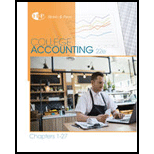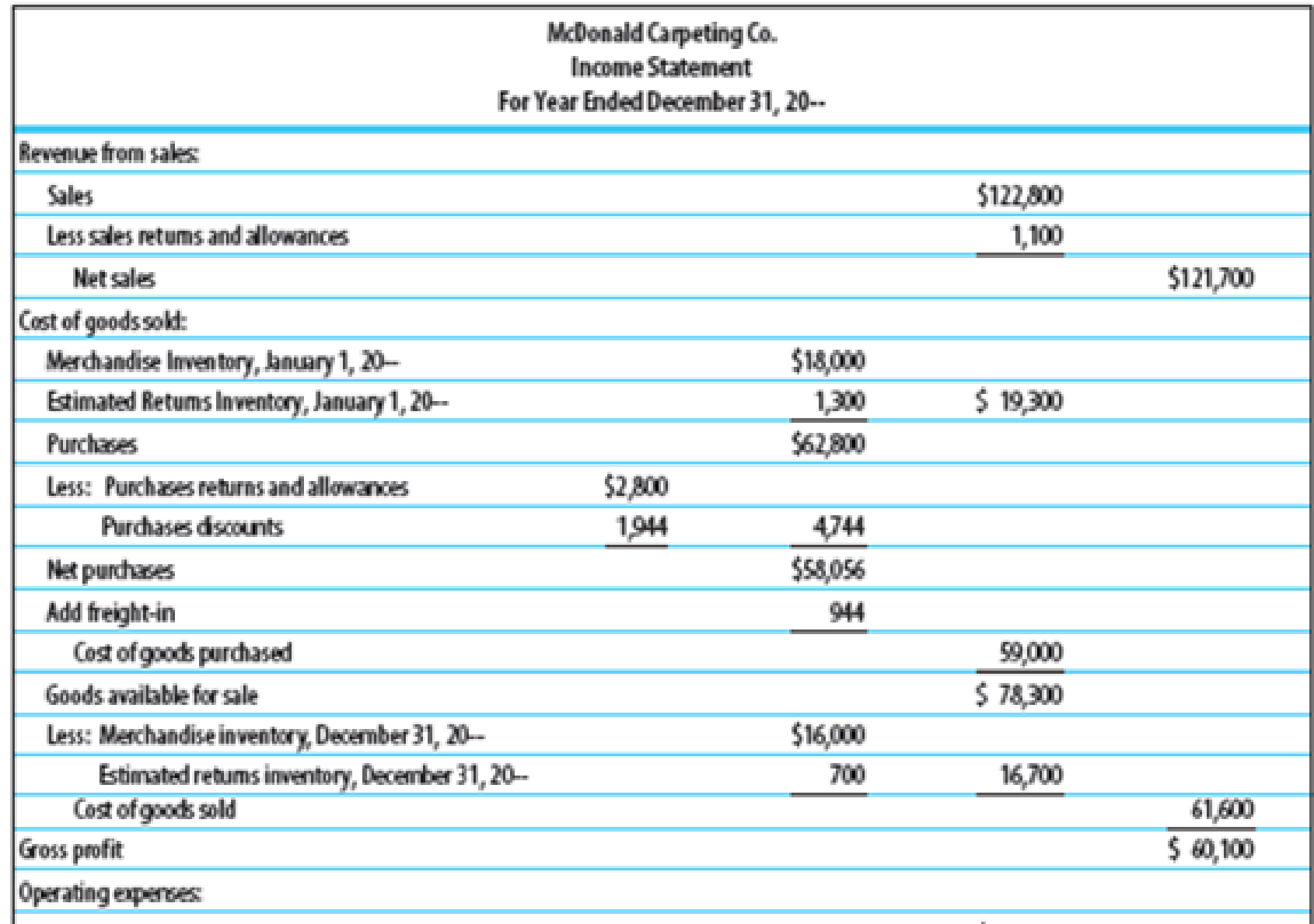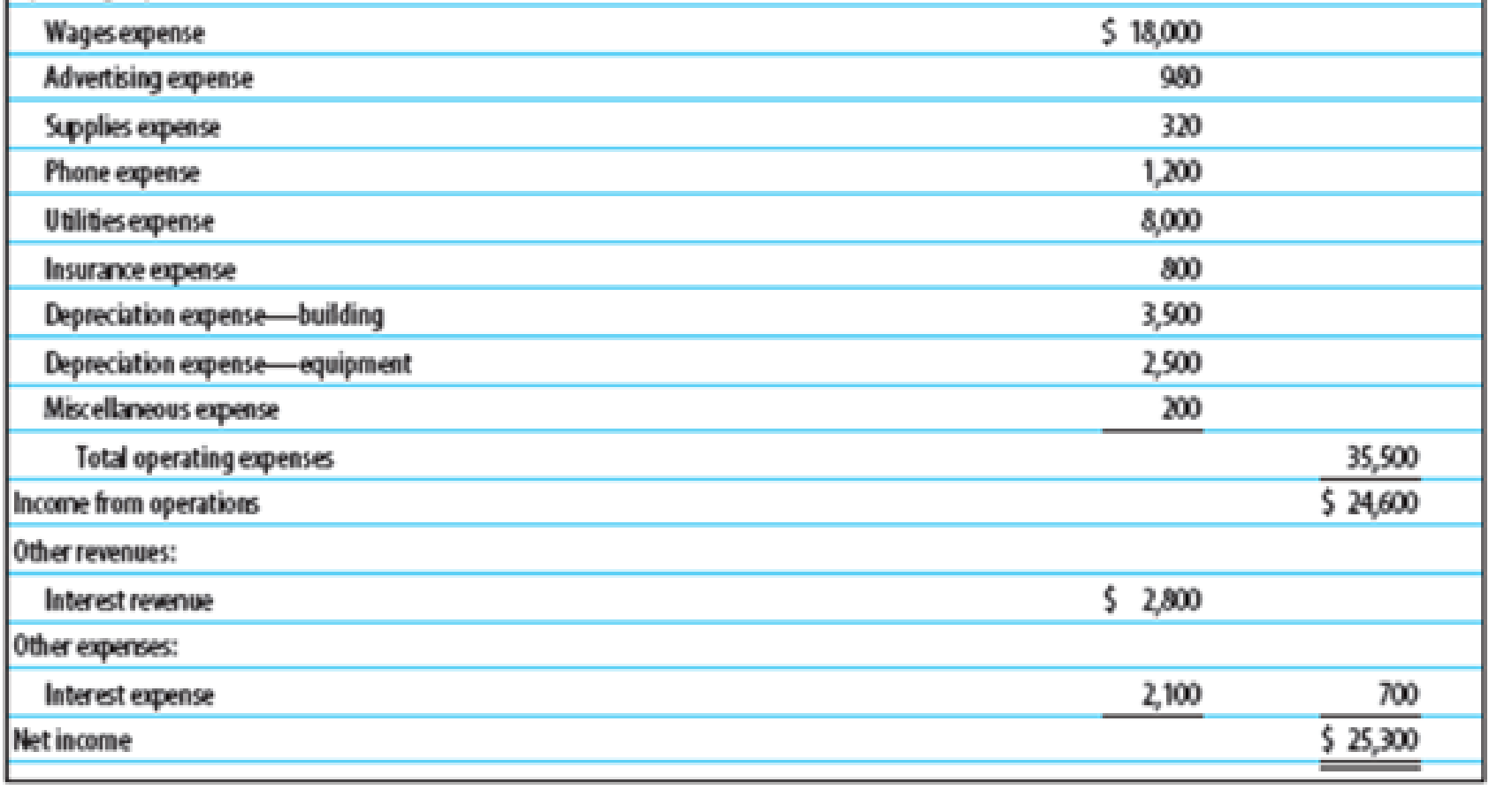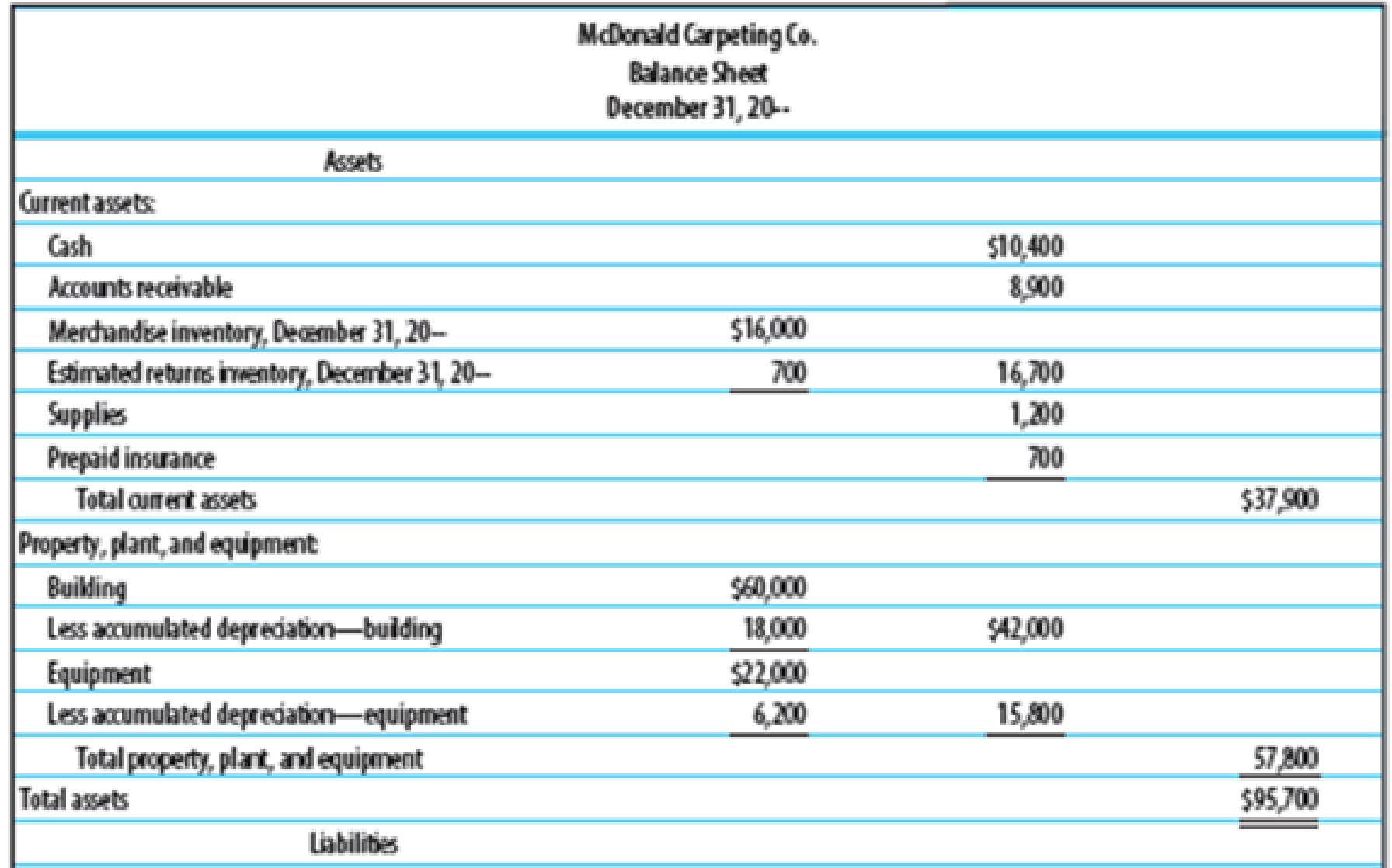
College Accounting, Chapters 1-27
23rd Edition
ISBN: 9781337794756
Author: HEINTZ, James A.
Publisher: Cengage Learning,
expand_more
expand_more
format_list_bulleted
Textbook Question
Chapter 15, Problem 4SEB
FINANCIAL RATIOS Based on the financial statements, shown on pages 603–604, for McDonald Carpeting Co. (income statement, statement of owner’s equity, and
- 1.
Working capital - 2.
Current ratio - 3. Quick ratio
- 4. Return on owner’s equity
- 5. Accounts receivable turnover and average number of days required to collect receivables
- 6. Inventory turnover and average number of days required to sell inventory





Expert Solution & Answer
Trending nowThis is a popular solution!

Students have asked these similar questions
Please provide answer this financial accounting question
Brentwood Manufacturing forecasts that total overhead for the current year will be $12,000,000 and that total machine hours will be 240,000 hours. Year to date, the actual overhead is $13,200,000, and the actual machine hours are 260,000 hours. Suppose Brentwood Manufacturing uses a predetermined overhead rate based on machine hours for applying overhead as of this point in time (year to date). In that case, the overhead is? Help
Solve this Accounting problem
Chapter 15 Solutions
College Accounting, Chapters 1-27
Ch. 15 - LO1 A multiple-step form of income statement...Ch. 15 - Prob. 2TFCh. 15 - Prob. 3TFCh. 15 - Prob. 4TFCh. 15 - LO4 Accounts receivable turnover is the number of...Ch. 15 - Prob. 1MCCh. 15 - Prob. 2MCCh. 15 - Prob. 3MCCh. 15 - Prob. 4MCCh. 15 - Prob. 5MC
Ch. 15 - Prob. 1CECh. 15 - Prob. 2CECh. 15 - Prob. 3CECh. 15 - Prob. 4CECh. 15 - Prob. 5CECh. 15 - Prob. 6CECh. 15 - Prob. 1RQCh. 15 - Prob. 2RQCh. 15 - Describe how to calculate the following ratios (a)...Ch. 15 - Where is the information obtained that is needed...Ch. 15 - Explain the function of each of the four closing...Ch. 15 - What is the purpose of a post-closing trial...Ch. 15 - What is the primary purpose of reversing entries?Ch. 15 - What is the customary date for reversing entries?Ch. 15 - What adjusting entries should be reversed?Ch. 15 - REVENUE SECTION. MULTIPLE-STEP INCOME STATEMENT...Ch. 15 - COST OF GOODS SOLD SECTION, MULTIPLE-STEP INCOME...Ch. 15 - MULTIPLE-STEP INCOME STATEMENT Use the following...Ch. 15 - FINANCIAL RATIOS Based on the financial statements...Ch. 15 - CLOSING ENTRIES Using the spreadsheet and...Ch. 15 - REVERSING ENTRIES From the spreadsheet used in...Ch. 15 - ADJUSTING, CLOSING, AND REVERSING ENTRIES Prepare...Ch. 15 - INCOME STATEMENT, STATEMENT OF OWNERS EQUITY, AND...Ch. 15 - FINANCIAL RATIOS Use the spreadsheet and financial...Ch. 15 - END-OF-PERIOD SPREADSHEET, ADJUSTING, CLOSING, AND...Ch. 15 - REVENUE SECTION, MULTIPLE-STEP INCOME STATEMENT...Ch. 15 - COST OF GOODS SOLD SECTION, MULTIPLE-STEP INCOME...Ch. 15 - MULTIPLE-STEP INCOME STATEMENT Use the following...Ch. 15 - FINANCIAL RATIOS Based on the financial...Ch. 15 - CLOSING ENTRIES Using the spreadsheet and...Ch. 15 - Prob. 6SEBCh. 15 - Prob. 7SEBCh. 15 - INCOME STATEMENT, STATEMENT OF OWNERS EQUITY, AND...Ch. 15 - FINANCIAL RATIOS Use the work sheet and financial...Ch. 15 - END-OF-PERIOD SPREADSHEET, ADJUSTING, CLOSING, AND...Ch. 15 - Prob. 1MYWCh. 15 - Dominique Fouque owns and operates Dominiques Doll...Ch. 15 - Prob. 1CPCh. 15 - Comprehensive Problem 2: Accounting Cycle with...Ch. 15 - Comprehensive Problem 2: Accounting Cycle with...Ch. 15 - Comprehensive Problem 2: Accounting Cycle with...Ch. 15 - Comprehensive Problem 2: Accounting Cycle with...Ch. 15 - Comprehensive Problem 2: Accounting Cycle with...Ch. 15 - Comprehensive Problem 2: Accounting Cycle with...Ch. 15 - Comprehensive Problem 2: Accounting Cycle with...Ch. 15 - Comprehensive Problem 2: Accounting Cycle with...Ch. 15 - Comprehensive Problem 2: Accounting Cycle with...Ch. 15 - Prob. 2.1COPCh. 15 - Comprehensive Problem 2: Accounting Cycle with...Ch. 15 - Comprehensive Problem 2: Accounting Cycle with...Ch. 15 - Prob. 2.4COPCh. 15 - Prob. 2.5COPCh. 15 - Comprehensive Problem 2: Accounting Cycle with...Ch. 15 - Comprehensive Problem 2: Accounting Cycle with...Ch. 15 - Prob. 2.8COP
Knowledge Booster
Learn more about
Need a deep-dive on the concept behind this application? Look no further. Learn more about this topic, accounting and related others by exploring similar questions and additional content below.Similar questions
- Brentwood Manufacturing forecasts that total overhead for the current year will be $12,000,000 and that total machine hours will be 240,000 hours. Year to date, the actual overhead is $13,200,000, and the actual machine hours are 260,000 hours. Suppose Brentwood Manufacturing uses a predetermined overhead rate based on machine hours for applying overhead as of this point in time (year to date). In that case, the overhead is?arrow_forwardCan you help me with accounting questionsarrow_forwardWhat is the ending balance in stockholders equity?arrow_forward
- hi expert please help mearrow_forwardSummit Mechanical Co. has a normal capacity of 25,000 direct labor hours. The company's variable costs are $32,500, and its fixed costs are $18,750 when operating at normal capacity. What is its standard manufacturing overhead rate per unit?arrow_forwardhello teacher please solve questionsarrow_forward
- Opereting leverage?arrow_forwardSuppose Loc Motors, Inc. has 720 million shares outstanding with a share price of $65.20, and $30.85 billion in debt. If in three years, Loc Motors has 770 million shares outstanding trading for $78.45 per share, how much debt will Loc Motors have if it maintains a constant debt-equity ratio? The amount of debt required in three years will be $_ billion. Accounting problemarrow_forwardGeneral Accountingarrow_forward
arrow_back_ios
SEE MORE QUESTIONS
arrow_forward_ios
Recommended textbooks for you
 College Accounting, Chapters 1-27 (New in Account...AccountingISBN:9781305666160Author:James A. Heintz, Robert W. ParryPublisher:Cengage Learning
College Accounting, Chapters 1-27 (New in Account...AccountingISBN:9781305666160Author:James A. Heintz, Robert W. ParryPublisher:Cengage Learning College Accounting, Chapters 1-27AccountingISBN:9781337794756Author:HEINTZ, James A.Publisher:Cengage Learning,
College Accounting, Chapters 1-27AccountingISBN:9781337794756Author:HEINTZ, James A.Publisher:Cengage Learning, Managerial AccountingAccountingISBN:9781337912020Author:Carl Warren, Ph.d. Cma William B. TaylerPublisher:South-Western College Pub
Managerial AccountingAccountingISBN:9781337912020Author:Carl Warren, Ph.d. Cma William B. TaylerPublisher:South-Western College Pub Managerial Accounting: The Cornerstone of Busines...AccountingISBN:9781337115773Author:Maryanne M. Mowen, Don R. Hansen, Dan L. HeitgerPublisher:Cengage LearningPrinciples of Accounting Volume 1AccountingISBN:9781947172685Author:OpenStaxPublisher:OpenStax College
Managerial Accounting: The Cornerstone of Busines...AccountingISBN:9781337115773Author:Maryanne M. Mowen, Don R. Hansen, Dan L. HeitgerPublisher:Cengage LearningPrinciples of Accounting Volume 1AccountingISBN:9781947172685Author:OpenStaxPublisher:OpenStax College Survey of Accounting (Accounting I)AccountingISBN:9781305961883Author:Carl WarrenPublisher:Cengage Learning
Survey of Accounting (Accounting I)AccountingISBN:9781305961883Author:Carl WarrenPublisher:Cengage Learning

College Accounting, Chapters 1-27 (New in Account...
Accounting
ISBN:9781305666160
Author:James A. Heintz, Robert W. Parry
Publisher:Cengage Learning

College Accounting, Chapters 1-27
Accounting
ISBN:9781337794756
Author:HEINTZ, James A.
Publisher:Cengage Learning,

Managerial Accounting
Accounting
ISBN:9781337912020
Author:Carl Warren, Ph.d. Cma William B. Tayler
Publisher:South-Western College Pub

Managerial Accounting: The Cornerstone of Busines...
Accounting
ISBN:9781337115773
Author:Maryanne M. Mowen, Don R. Hansen, Dan L. Heitger
Publisher:Cengage Learning

Principles of Accounting Volume 1
Accounting
ISBN:9781947172685
Author:OpenStax
Publisher:OpenStax College

Survey of Accounting (Accounting I)
Accounting
ISBN:9781305961883
Author:Carl Warren
Publisher:Cengage Learning
Financial ratio analysis; Author: The Finance Storyteller;https://www.youtube.com/watch?v=MTq7HuvoGck;License: Standard Youtube License